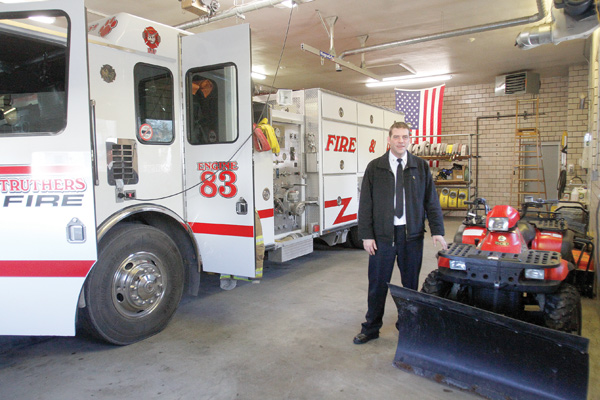Struthers officials mull funding for new main fire station


Struthers Fire Chief Gary Mudryk can park only one fire engine inside the main fire station on Elm Street. The station, built in 1943, simply can’t support the weight of the city’s two engines, which are a combined 70,000 pounds. In 1943, one firetruck weighed about 15,000 pounds.
SEE ALSO: Struthers Foundation awards 4 grants
STRUTHERS
The city’s fire
chief says he won’t be too picky about the site of a proposed new fire station.
Chief Gary Mudryk has been contending with an aging, cracking main fire station that is unable to handle the weight of the department’s two engines, has a constant stream of water that flows through the basement and lacks the space for sufficient training and sleeping facilities.
“I’ll take anything,” Mudryk said.
Built in 1943, the station at 96 Elm St. just wasn’t made to support two fire engines weighing a combined 70,000 pounds. Back then, one firetruck weighed about 15,000 pounds — and also was substantially smaller in size. Today, two engines can barely fit inside the station.
The excess weight began to take its toll on the building a few years ago when a horizontal crack appeared in the concrete block wall in the basement hallway adjacent to the garage bays. The firetrucks were, basically, pushing in the wall.
Left with no other choice, the department removed its backup truck from the station, then moved its main engine to the middle of the bay floor. This decision served as a temporary fix to the weight problem, but also rendered the backup truck not easily accessible.
The decision also didn’t do anything to solve another major issue affecting the station’s structural integrity: the water leaks and subsequent mold, likely caused by a spring on the property that was filled in when the station was built.
“You’re gambling,” said former Chief Harold Milligan Jr., who headed the department from 1980 to 2011, regarding how much longer the station will remain functional. “It’s like predicting an earthquake in San Francisco.”
But though city officials agree the need for a new fire station exists, the funding for it doesn’t — at least not right now.
A recent study by MS Consultants Inc. of Youngstown found that a 7,300-square-foot main fire station with two garage bays would cost about $1.7 million. The study also offered up four potential locations for the new station, including a few properties already owned by the city.
Mayor Terry Stocker said early support centered on city-owned property at Stewart and Elm streets, where the closed skate park is located. This option would create a campus-like environment for the fire, police and street departments, along with city-hall activities, Stocker said, but concerns exist regarding the large amount of traffic there during the day.
Other initial options are the current fire-station property, a church property at Elm Street and Elm Court and city-owned property at the northeast corner of Elm and Garfield streets.
The proposed locations are producing discussions.
Both Michael Patrick, councilman at-large, and Councilman Tony Fire, D-1st, for example, said they think the church property would be a viable location for the new station, in part because of its triangular lot shape that would make pulling the trucks in and out much easier.
In addition, the property is large enough to meet all future needs such as additional parking spaces and station expansion. The property also is flat, which would require minimal site preparation.
But the most-pressing need, Stocker said, is to first identify a funding source before any discussions can move forward. Grant money would be ideal but perhaps not likely. Putting a levy on the ballot also could be a possibility.
Stocker said he’s also exploring the possibility of obtaining a low-interest loan through the U.S. Department of Agriculture.
Stocker and Ed Wildes, the city’s safety-service director, both acknowledged the current station has outlived its usefulness, but that there’s still time to address the problem. They said something should be done within the next three years, with a plan formulated in the next year or two.
“Frankly, I know it’s a pipe dream,” Mudryk said. “But rather than sitting flat-footed, we’re ready — with spots picked out, an idea of the station we want and why we need it.”
 43
43
